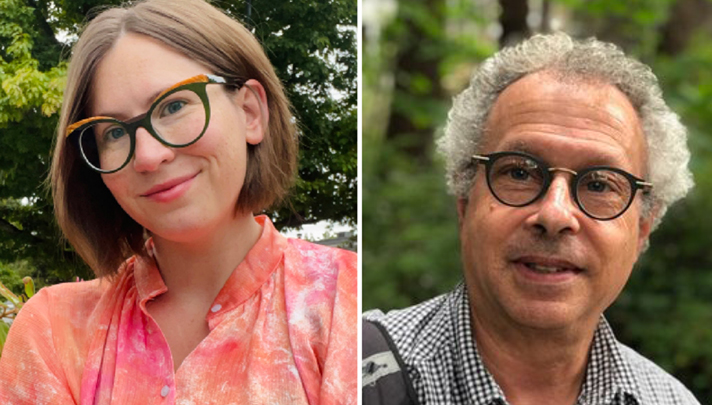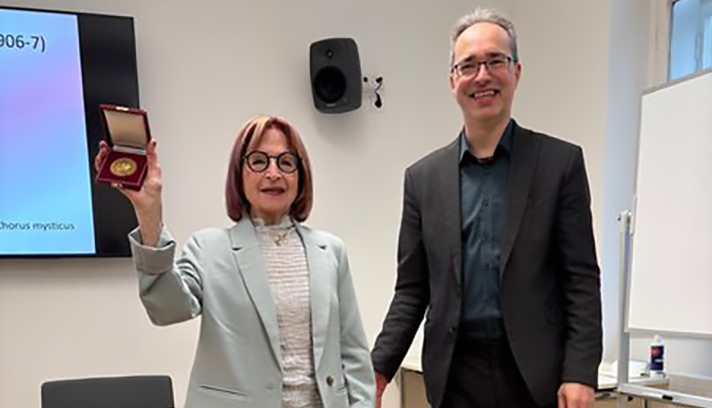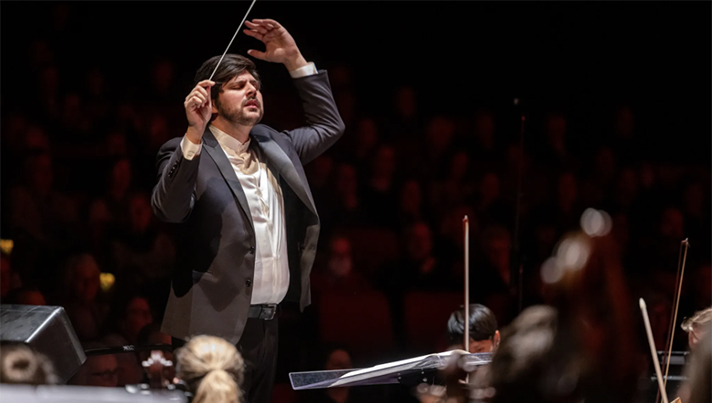An exciting new multimedia collaboration between Professor Bob Pritchard and Turning Point Ensemble imagines one possible future for humanity — and points to another for classical music performance
WATCH: Synapses (6:15)
An oboist wanders barefoot in near-darkness. He plays a string of searching notes, trails off, and begins again, elaborating the melody. He stops, peers. Ahead, curled up on the ground, lies a body. The oboist removes the mouthpiece from his instrument and blows into the barrel. A light flickers, and there is movement. The figure of a cyborg staggers to its feet, vertebral loops pulsing a deep blue. Who are these two strangers? Creator and creation? Master and servant? Adversaries?
So begins Synapses, a new multimedia collaboration spearheaded by Professor of Composition Dr. Bob Pritchard and oboist David Owen of Vancouver’s Turning Point Ensemble. The project, which premiered in January as part of the Chan Centre’s winter programming, takes up one of the challenges musicians face right now: How do you bridge the gap between performer and audience that has opened up during the COVID-19 pandemic?
“When [COVID] hit, live performances just stopped. It was adapt or die,” Owen says.
Synapses originated with an unusual commission and a wildly inventive piece of technology. Turning Point, one of Vancouver’s pre-eminent classical music collectives, launched a new initiative that would allow member musicians like Owen to commission new music from Canadian composers and work with filmmakers to realize them visually. They would be performed, recorded, and packaged together as 1 + 1 + 1+…, an ambitious streaming video series.
“The idea was to be as creative as possible, to offer something beyond the experience our audiences would get at live show. I immediately thought of Bob Pritchard,” Owen says.
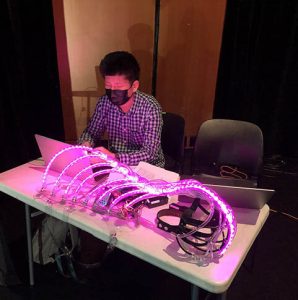

Research assistant Daniel Tsui programs the light spine
For Prof. Pritchard, the timing was perfect: “I happened to be working on a new piece of wearable tech, and I was beginning to think about how I might compose music for it,” he says.
The tech in question was a light spine — a harness with user-activated LED loops, or “vertebrae” — that could be attached to a bodysuit and triggered to flash, fade, and change colour in response to motion or sound. The light spine concept emerged from Prof. Pritchard’s SSHRC-funded research project to develop sensors and tracking systems for performance, and evolved with input from research assistants Daniel Tsui and Danielle Lee (both School of Music graduates), and collaborators Emmalena Fredriksson, a dancer/choreographer, and Alaia Hamer, a costume designer.
“We went through a couple of versions before we landed on the final one. Alaia is fantastic, and to have a costume like that made to fit is unreal. It [made me] feel like a cyborg that was created for some sort of battle,” Fredriksson says.
When Prof. Pritchard sat down to compose the music for Owen, a post-apocalyptic scene had begun to take shape in his mind. “I wanted the oboe part to show off David’s incredible technique… in a way that was idiomatic for the instrument, with rapid fingering, multi-phonics, and breath sounds,” he says.
By design, there was space for collaboration in every aspect of the project, including the composition itself.
“Bob wrote a framework piece that was pretty detailed, but there was a lot of stuff I had to write and create to fit into it. I had to make up fingerings for the particular note patterns he wanted — the multi-phonics,” Owen says. “That was quite different from the traditional way of doing things, where the composer writes the music and you, the musician, just learn it.”
“Will people want to go back to a closed box with 2,000 people listening to symphony orchestra? I don’t know. I think arts organizations would be wise to consider this and create alternative forms of performance.”
— David Owen, oboist
As Prof. Pritchard experimented with incorporating the breath sounds into the composition, he began to think that Owen’s character could “awaken” Fredriksson’s. He fleshed out the idea musically with Owen, while Fredriksson developed the choreography for the cyborg. But it was during filming that the story began to really take shape.
“I’d created movement for each part, taking the cyborg on a journey from collapsed on the ground into a vertical stance,” Fredriksson says. “When David came into the studio it changed everything. I had a direction in which to anchor my energy, to push and pull from. The master-and-creature relationship became so much clearer.”
Owen felt this too. “During the actual filming, it changed from take to take. The relationship between creature and oboist became more confrontational by the end, as in what you see in the finished film,” he says.
Watching the dynamic evolve in real time, Prof. Pritchard added a final technical flourish. He attached an accelerometer to Owen’s wrist. While Fredriksson’s cyborg dances low to the ground, struggling to rise, Owen’s oboist repeatedly throws one arm into the air, as if to say Rise! His gesture triggers a burst of dramatic pre-recorded sound, and with each repetition, the cyborg rises a little taller. When finally the two characters meet eye to eye, the gesture becomes uncertain, defensive: Stay back!, Owen’s character now seems to say. The scene fades to black with the confrontation unresolved.
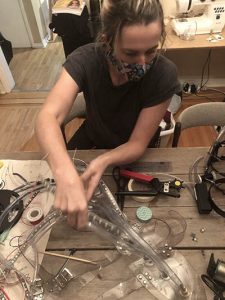

Costume designer Alaia Hamer making the harness
For filmmaker Sean Patrick Shaul, making Synapses was a unique experience: “The light suit and Emmalena’s movements added these extra elements of story that I couldn’t have even dreamed up myself,” he says. “I’ve found that during the pandemic my artist friends were the first to pivot and make something happen in uncharted territory. This video is a perfect example.”
But what happens after the pandemic, when life — and art-making — returns to some kind of normal?
“Will people want to go back to a closed box with 2,000 people listening to symphony orchestra? I don’t know. I think arts organizations would be wise to consider this and create alternative forms of performance,” Owen says.
Right now, it’s difficult to imagine life without COVID. For Prof. Pritchard and his Music Technology students, at least, finding novel ways to create and perform music has always been the challenge they set for themselves.
“In my lab, we face constraints of equipment, programming abilities, performance abilities, space, and time. Often a piece turns out much better than originally presented, because students have managed to create solutions to the problems or include the problems in the piece,” he says.
Plans are already in the works to film two more versions of Synapses, featuring solo performances by Owen and Fredriksson, as well as a stage version that will be performed for live audiences — in a future that still feels far away.
